Problem Analysis in Sub-Assembly Department Using Empathize Design Thinking and Failure Mode Effects Analysis: A Case Study of PT X
DOI:
https://doi.org/10.33479/jtiumc.v3i1.47Kata Kunci:
Design Thinking, Empathize, Failure Mode Effects and Analysis, Sub-AssemblyAbstrak
PT X is a company that engages in the production of large vehicles, particularly buses. The company currently has a sub-assembly department responsible for providing support materials used in the production process. Within the sub-assembly department, there are several constraints that affect the ongoing production process. These hindrances can lead to various losses for the company. Therefore, a study is being conducted to identify and understand the obstacles present in the sub-assembly department. The problem identification process employs the empathize stage of design thinking, aiming to determine the importance of each problem. To achieve this, a ranking system known as Failure Mode Effects and Analysis is being utilized. The results indicate the existence of six problems within the sub-assembly department. Following the prioritization process, it was determined that the primary issue revolves around inadequate administrative procedures. Based on these findings, an evaluation is planned for the company, specifically focusing on the sub-assembly department. The objective is to promptly address these problems and prevent any significant impacts on the company. This abstract emphasizes the importance of identifying departmental issues and prioritizing immediate solutions.
Referensi
Anggi. (2018). FMEA adalah: Pengertian dan cara menerapkannya di dalam manajemen perusahaan. Retrieved 10 February, 2023, from https://accurate.id/marketing-manajemen/fmea-adalah/
Cahyabuana, B. D., & Pribadi, A. (2014). Konsistensi penggunaan metode FMEA (Failure Mode Effects and Analysis) terhadap penilaian resiko teknologi informasi (Studi kasus: Bank XYZ). ITS Repository, 1-9. https://repository.its.ac.id/287/1/5211100011-paperpdf.pdf
Carlson, C. S. (2014, January). Understanding and applying the fundamentals of FMEAs. In Annual Reliability and Maintainability Symposium (Vol. 10, pp. 1-35).
Casadei, D., Serra, G., & Tani, K. (2000). Implementation of a direct control algorithm for induction motors based on discrete space vector modulation. IEEE transactions on power electronics, 15(4), 769-777.
Dam, R. F. (2022). The five stages in the design thinking process. Retrieved February 11, 2023, from https://www.interaction-design.org/literature/article/5-stages-in-the-design-thinking-process.
Fadila, R. (2021). Perkembangan transportasi bus di Indonesia. Retrieved February 11, 2023, from https://www.kompasiana.com/raihanfadilamedia/619a07f206310e47d3718722/perkembangan-transportasi-bus-di-indonesia
Hidayat, N. F. (2017). Usulan peningkatan kualitas dan minimasi cacat pada produk Thread Protector diameter 4” dengan metode Six Sigma di PT. Plasindo Elok [Unpublished Undergraduate Thesis]. Universitas Esa Unggul.
Kelley, D., & Brown, T. (2018). An introduction to Design Thinking. Institute of Design at Stanford.
Nuchpho, P., Nansaarng, S., & Pongpullponsak, A. (2014, March). Risk Assessment in the organization by using FMEA Innovation: A Literature Review. In Proceedings of the 7th International Conference on Educational Reform (ICER 2014). Innovations and Good Practices in Education: Global Perspectives (pp. 781-789).
Susanto, A.H. & Purnomo, P., 2022. Perancangan Strategi Pemasaran dan Peningkatan Kualitas Produk Pakan Burung pada IKM Sinar Mas Malang dengan Metode SWOT dan FMEA. Jurnal Sains dan Aplikasi Keilmuan Teknik Industri (SAKTI), 2(1), 19-26. https://doi.org/10.33479/jtiumc.v2i1.21
Stamatis, D. H. (1995). Failure mode and effect analysis: FMEA from theory to execution. Milwaukee: ASQC Quality.
Puspitasari, N.B., Arianie, G.P., & Wicaksono, P.A. (2017). Analisis Identifikasi Masalah Menggunakan Metode Failure Mode and Effect Analysis (FMEA) dan Risk Priority Number (RPN) pada Sub-Assembly Line (Studi Kasus: PT. Toyota Motor Manufacturing Indonesia). Jurnal Teknik Industri (J@ti Undip), 1(12), 77-84.
Tanu, Y., & Purnomo, P. (2021). Manajemen Risiko Perencanaan Optimalisasi Pembangunan Jembatan Utama PT Wijaya Karya dengan Metode Failure Mode and Effects Analysis. Jurnal Sains dan Aplikasi Keilmuan Teknik Industri (SAKTI), 1(2), 63-70. https://doi.org/10.33479/jtiumc.v1i2.9
Widianti, T., & Firdaus, H. (2015). Failure mode and effect analysis (FMEA) sebagai tindakan pencegahan pada kegagalan pengujian. 10th Annual Meeting on Testing and Quality 2015, 131-147.
Widodo, A.C., & Wahyuni, W.G. (2021). Penerapan Metode Pendekaan Design Thinking dalam Rancangan Ide Bisnis Kalografi. Jurnal Automata, 2(2).
Unduhan
Diterbitkan
Cara Mengutip
Terbitan
Bagian
Lisensi
Hak Cipta (c) 2023 Jurnal Sains dan Aplikasi Keilmuan Teknik Industri (SAKTI)

Artikel ini berlisensiCreative Commons Attribution-NonCommercial-ShareAlike 4.0 International License.









